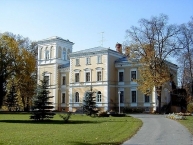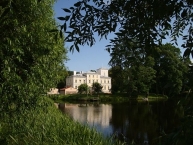Radweg Limbaži-Saulkrasti-Birini-Limbaži
Nr. des Radweges LV 109
Aktionen
![]()
Bitte warten - Kartendaten werden geladen
Erstellt am 29.08.2014,
zuletzt geändert von Ottocolor am 16.10.2023
Aktionen
Strecken-Merkmale
Gesamtlänge in km
93
Informationen zu Rechten an den GPS-Track-Daten | |
|---|---|
Rechte-Inhaber | OpenStreetMap and Contributors + biroto-Redaktion (biroto.eu) |
Rechte-Ausprägung / Lizenz | Enthält Daten von OpenStreetMap, die hier unter der Open Database License(ODbL) verfügbar gemacht werden |
Link zur Rechtebeschreibung | |
gpx-Datei übernommen aus | |
gpx-Datei hochgeladen | durch biroto-Redaktion am 16.10.2023
|
Gesamtzahl Trackpoints
994
Trackpoint-Dichte per km
11
Endorte
Start
Limbaži, LV (74 m NHN)
Ziel
Limbaži, LV (74 m NHN)
Charakter
Latvian regional route no. 109 is a round trip in western Livonia (latvian Vidzeme) beginning and ending in the medium sized town of Limbaži. It goes south to the coastline at Saulkrasti, and from there into the countryside and then north back to Limbaži.
Informationen zu Urheber-Rechten | |
|---|---|
Rechte-Ausprägung / Lizenz | by-sa: CREATIVE COMMONS Namensnennung, Weitergabe unter gleichen Bedingungen |
Link zur Rechtebeschreibung | |
übernommen / bearbeitet am | 29.08.2014
|
übernommen / bearbeitet durch |
|
Fahrradfreundliche Unterkünfte, Sehenswertes und Infrastruktur
Name u. Anschrift
Breite / Länge
Tel.
Fax.
Mobile
Art d. Unterkunft
Radler-freund-lichkeit
Strecken-km
km zur Strecke
Höhe
1 km
0,2 km
66 m
16 km
0,1 km
52 m
16 km
0,0 km
49 m
Informationen zu Urheber-Rechten | |
|---|---|
Rechte-Inhaber | https://web.archive.org/web/20161012173922/www.panoramio.com/photo/10441656 |
Rechte-Ausprägung / Lizenz | by: CREATIVE COMMONS Namensnennung |
Link zur Rechtebeschreibung | |
Bild übernommen aus | https://commons.wikimedia.org/wiki/File:Igates_pils_2000-10-07.jpg |
Bild hochgeladen | durch biroto-Redaktion am 15.02.2021
|
Informationen zu Urheber-Rechten | |
|---|---|
Rechte-Inhaber | https://web.archive.org/web/20161029183906/www.panoramio.com/user/36569?with_photo_id=2432315 |
Rechte-Ausprägung / Lizenz | by-sa: CREATIVE COMMONS Namensnennung, Weitergabe unter gleichen Bedingungen |
Link zur Rechtebeschreibung | |
Bild übernommen aus | https://commons.wikimedia.org/wiki/File:Igate_manor_-_panoramio.jpg |
Bild hochgeladen | durch biroto-Redaktion am 15.02.2021
|
Das Schloss Igate befindet sich in Igate, Gemeinde Vidriži, Bezirk Limbaži. Es wird erstmals 1455 in Schriften erwähnt, als Idsel Diderik Fitinghof das Dorf und das Herrenhaus an Peter von der Borham verkaufte. Der Name des Herrenhauses hat sich mehrmals geändert.
Um 1880 wurde in Igate ein Herrenhaus im Neorenaissance-Stil errichtet. Das Gebäude wurde von Rudolf Heinrich Zircwitz von Pistolkors entworfen und demonstriert zurückhaltenden und raffinierten Lakonismus. 1934 wurde das Herrenhaus von der Lettischen Kinderunion gekauft und es gab ein Kinderinternat im Schloss. Im Sommer 1940 wurde es in ein Waisenhaus umgewandelt. Ab 1972 stand Igate Castle unter der Kontrolle des Landwirtschaftsministeriums. 1996 wurde Igate Castle von der State Real Estate Agency übernommen.
Informationen zu Urheber-Rechten | |
|---|---|
Rechte-Ausprägung / Lizenz | by-sa: CREATIVE COMMONS Namensnennung, Weitergabe unter gleichen Bedingungen |
Link zur Rechtebeschreibung | |
Text(e) übernommen von: |
Vikipēdijas dalībnieki, 'Igates pils', Vikipēdija, Brīvā enciklopēdija, 10 jūnijs 2020, 02.56 UTC, [iegūts 15 februāris 2021] |
übernommen / bearbeitet am | 20.09.2011 - 15.02.2021
|
übernommen / bearbeitet durch |
|
33 km
0,8 km
47 m
51 km
0,1 km
21 m
![]()


